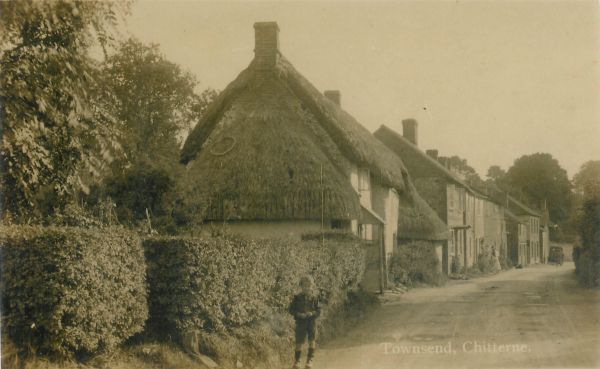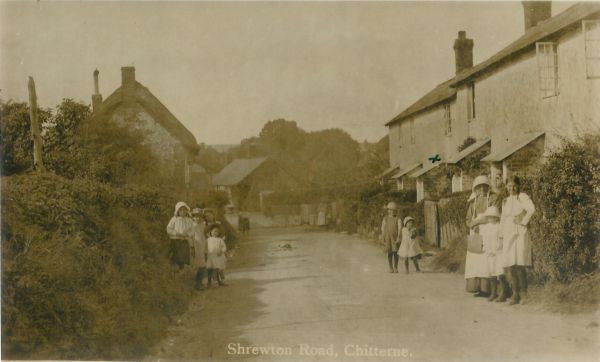
Friday 24th September 2013 - Townsend and Bidden Lane Query

These are scans of photograph copies of old early 20th century postcards of Townsend and Bidden Lane, so they are not as clear as I'd like. They were sent to me from Australia by the niece of an Australian WW1 soldier, who died in France in May 1918, but more of that later.
Notice the thatched cottages in the middle foreground of the first photo. They were numbers 7 and 8 Townsend and stood where Polly's bungalow is now. The pair of cottages were built of cob with brick floors, usually covered with coconut matting. They both had large inglenook fireplaces with beams and chains suspending hooks for a cauldron over the fire. In 1911 the Garland family lived in number 7 and the Furnells in number 8.
The little boy, wonder who he is, stands in front of the site now occupied by Fieldview bungalow.
Further down the road the cottages numbers 9 to 14 look much the same as they do today, number 15 is hidden but look at number 16, what is now the Bakehouse. It looks quite different and so much smaller than number 17 the shop next door. This is not surprising because John and Eileen Brown, former owners of the shop, had number 16 completely rebuilt for their retirement in 1974. Number 17, the former shop and post office was built in 1861 by Jacob Smith and would have been still run by his sons when this photo was taken. The little cottage squeezed between the shop and Honeysuckle cottage was number 18, and is now part of number 17. The vehicle in the distance could be the shop delivery van.

The lady who sent me these pictures wanted to trace any descendants of the couple who had been so very kind to her uncle, a corporal in the AIF, when he was staying at the camp in Codford in 1917. Her uncle and his mate had been treated to tea and cakes on many a Sunday afternoon, and attended the Sunday Service at the Chapel with the family too. The kind couple had lived in Bidden Lane at the cottage marked with a cross on the photo, which I identified as number 64. Unforunately the lady's uncle had not mentioned the couple's name in his frequent letters home to his parents in Australia and so I looked in the records to see if I could identify them that way. In 1911 the cottage was occupied by William & Alice Ford, but sadly William and Alice had both died by the end of 1912. In Reverend Canner's Visiting Book notes of 1925 the cottage was occupied by William Bacon and family, but William Bacon was himself away in 1917 fighting in the war, so it couldn't have been that family, although the Bacons were chapel-goers. I consulted GD to see if William Bacon's war records would give a clue to his home address but, wouldn't you know, his records were lost! So, I am stuck with a seemingly inpenetrable gap in the records between 1911 and 1925.
Friday 13th September 2013 - A Curious Coincidence
I know, I know, long time, no blog, but this has been a summer to enjoy, hasn't it? If it had been rainy there would have been more blogs! It's rained today, so here I am.
It's not that there has been a shortage of things to write about either. This story was brought to my attention a few weeks ago by JC, to whom many thanks. It concerns a former resident of Chitterne, the late William Worthington Topper, who moved into number 6 The Stables with his wife Susan, right after the old racing stables were converted in 1991.

William was an interesting man, he had been an RAF Mosquito pilot in World War 2, a member of 627 Squadron with many tales to tell of his flying exploits. One such tale concerned marking a target at Sassnitz on the Baltic. After the target had been marked and they were flying up and away from the harbour the Mosquito was caught in the beam of a searchlight, which stuck to them firmly no matter how William tried to lose it. After about a minute they veered to the right and the searchlight went out. They breathed again and made it back safely, but often recalled the incident in later years.
Then in 1997, when William was living in Chitterne, his next door neighbour at number 5 told him she was to marry a man from Bavaria called Hans Feldman. Hans and william became good friends and enjoyed swapping tales of their wartime experiences. It transpired that Hans had been an unwilling member of the Hitler Youth and had been sent to a Baltic port in Poland towards the end of the war where he saw his first Mosquito, a plane he thought was beautiful....William soon realised what was coming when Hans told of how he had been put in charge of a searchlight near the harbour, which was being attacked: "And William, one of the Mosquitoes passed right over our heads and I switched our lamp on and there it was, flying up the beam towards some white clouds. The guns nearby could have hit it easily". William of course asked why they didn't fire, and was told: "Because they had run out of ammunition, that happened often at the end of the war". When William told him who was in the plane, Hans said: "I'm glad we had no ammunition left".
The friendship continued despite Hans taking his bride to live in the States, where he had emigrated as soon as he could after the war, and when they came back to live in Britain again a couple of years later William would go and stay with them.
Sourced from an article called: 'The World is a Small Place' by William Topper on the '627 Squadron in Retirement' website.